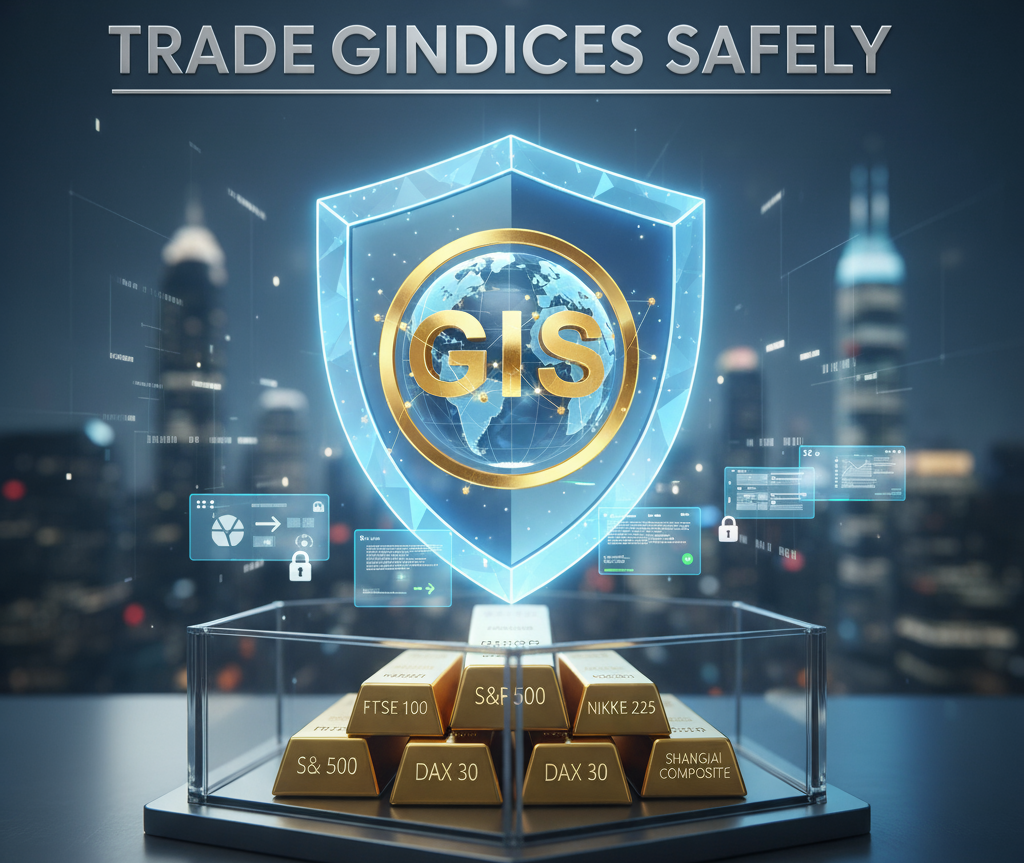How to Trade Global Indices Safely: Step-by-Step Guide for Beginners

When you decide to trade global indices safely, you’re opening the door to one of the most dynamic and accessible markets in the world. Index trading offers exposure to entire economies and sectors without the need to pick individual stocks—but like any investment, it requires knowledge, strategy, and discipline.
In this comprehensive guide, we’ll explore proven global index trading strategies, essential risk management techniques, and how to trade indices safely whether you’re a beginner or an experienced trader.
What Are Global Indices and Why Trade Them?
Global indices represent a basket of stocks from a particular market, sector, or region. Think of them as a “snapshot” of market performance:
- S&P 500: Tracks 500 large-cap U.S. companies
- FTSE 100: Represents the top 100 companies on the London Stock Exchange
- DAX 40: Germany’s premier stock index
- Nikkei 225: Japan’s leading stock market indicator
- Hang Seng: Hong Kong’s benchmark index
Why Traders Love Index Trading
Index trading has surged in popularity for several compelling reasons:
- Diversification: One trade gives you exposure to multiple companies
- Lower volatility: Indices typically fluctuate less than individual stocks
- Liquidity: Major indices offer excellent trading volumes
- No single-stock risk: Company-specific disasters won’t wipe out your position
- Extended trading hours: Many index derivatives trade nearly 24/5
“Index trading removes the guesswork of stock picking. You’re betting on the economy or sector, not on whether one CEO makes the right decision.” – Market Analyst, Bloomberg
Essential Global Index Trading Strategies
To trade global indices safely, you need a strategic approach that matches your goals, risk tolerance, and market outlook.

1. Trend Following Strategy
This approach works particularly well in index trading because major indices tend to establish clear trends.
How it works:
- Identify the prevailing trend using moving averages (50-day and 200-day are popular)
- Enter positions aligned with the trend direction
- Use trailing stops to protect profits as the trend continues
Best for: Swing traders and position traders who can hold positions for weeks or months
2. Range Trading Strategy
When markets move sideways, range trading can be highly effective.
| Strategy Component | Implementation | Risk Level |
|---|---|---|
| Entry Point | Near support levels | Medium |
| Exit Point | Near resistance levels | Medium |
| Stop Loss | Just below support | Low-Medium |
| Time Frame | Works best in 1-4 hour charts | N/A |
Best for: Day traders and scalpers during periods of market consolidation
3. Breakout Trading
Breakouts occur when an index moves beyond established support or resistance levels with increased volume.
Key indicators to watch:
- Price breaking through resistance with volume 50% above average
- Consolidation patterns (triangles, rectangles) preceding the breakout
- Fundamental catalysts supporting the move
Best for: Traders who can act quickly and manage risk with tight stops
4. News and Economic Data Trading
Major economic announcements create volatility in global indices. This strategy involves trading around scheduled events.
Critical economic indicators:
- Non-Farm Payroll (U.S.)
- GDP reports
- Central bank interest rate decisions
- Inflation data (CPI, PPI)
- Manufacturing PMI numbers
Pro tip: Always check an economic calendar and avoid holding positions through major unexpected announcements.
How to Trade Indices Safely: Risk Management Essentials
Safety in index trading isn’t about avoiding risk entirely—it’s about managing it intelligently. Here’s your comprehensive risk management framework:
Position Sizing: The 1-2% Rule
Never risk more than 1-2% of your trading capital on a single trade. This rule is fundamental to longevity in trading.
Example calculation:
- Trading account: $10,000
- Maximum risk per trade: $200 (2%)
- Entry price: 4,500
- Stop loss: 4,450
- Risk per contract: 50 points
- Position size: $200 ÷ 50 = 4 contracts maximum
Stop Loss Strategies
Stop losses are non-negotiable when you trade global indices safely. Here are three approaches:
- Percentage-based stops: Set stops 2-3% below your entry for swing trades
- Technical stops: Place stops just below support levels or above resistance
- Volatility-based stops: Use ATR (Average True Range) to set stops relative to market volatility
Diversification Across Indices
Don’t put all your capital into one index. Spread your exposure:
- Geographic diversification: Trade U.S., European, and Asian indices
- Sector diversification: Consider sector-specific indices (technology, healthcare, energy)
- Time diversification: Stagger your entries rather than going all-in at once
Choosing the Right Trading Platform
The platform you choose significantly impacts your ability to trade global indices safely.
Key Features to Look For
Essential criteria:
- ✓ Regulatory oversight (FCA, SEC, ASIC, or equivalent)
- ✓ Competitive spreads (typically 0.5-2 points on major indices)
- ✓ Robust risk management tools
- ✓ Fast execution speeds (critical for day trading)
- ✓ Educational resources and market analysis
- ✓ Demo account availability
Warning signs to avoid:
- ✗ Unregulated or offshore brokers
- ✗ Unusually wide spreads
- ✗ Poor customer reviews regarding withdrawals
- ✗ Pressure tactics from sales representatives
Technical Analysis for Index Trading
Mastering technical analysis is crucial for implementing effective global index trading strategies.
Essential Indicators for Index Traders
- Moving Averages
- Use 20, 50, and 200-period EMAs for trend identification
- Golden cross (50 above 200) = bullish signal
- Death cross (50 below 200) = bearish signal
- RSI (Relative Strength Index)
- Readings above 70 suggest overbought conditions
- Readings below 30 indicate oversold conditions
- Look for divergences between price and RSI
- MACD (Moving Average Convergence Divergence)
- Crossovers signal potential trend changes
- Histogram shows momentum strength
- Works excellently on daily and 4-hour charts
- Support and Resistance
- Previous highs/lows become future decision points
- Round numbers often act as psychological barriers
- Volume confirms the strength of these levels
Chart Patterns That Work
| Pattern | Type | Success Rate | Target |
|---|---|---|---|
| Head & Shoulders | Reversal | 60-65% | Height of pattern |
| Double Top/Bottom | Reversal | 65-70% | Pattern height |
| Ascending Triangle | Continuation | 70-75% | Triangle height |
| Flag Pattern | Continuation | 75-80% | Flagpole height |
Understanding Market Correlations
Sophisticated traders recognize that global indices don’t move in isolation.
Index Relationships to Watch
- U.S. Dollar Strength: Typically inverse to emerging market indices
- Oil Prices: Strong correlation with energy-heavy indices (FTSE 100, TSX)
- Bond Yields: Rising yields often pressure equity indices
- Gold: Often moves opposite to risk-on indices like the S&P 500
Practical application: If crude oil spikes, consider bullish positions on energy-related indices while being cautious on consumer-heavy indices.
Common Mistakes to Avoid
Even experienced traders fall into these traps. Here’s how to avoid them:
Overtrading
Trading every small movement destroys capital through commissions and poor decision-making. Solution: Have specific entry criteria and stick to them.
Ignoring Global Events
Indices react strongly to geopolitical events, elections, and policy changes. Solution: Subscribe to economic calendars and news alerts.
Emotional Trading
Revenge trading after losses or overconfidence after wins leads to disaster. Solution: Keep a trading journal and stick to your plan.
Neglecting the Bigger Picture
Getting lost in 5-minute charts while ignoring the daily trend is a recipe for confusion. Solution: Always start analysis from higher timeframes and zoom in.
Advanced Strategies for Experienced Traders
Once you’ve mastered the basics of how to trade indices safely, consider these advanced approaches:
Pairs Trading
Trade the spread between two correlated indices (e.g., S&P 500 vs. Nasdaq 100). When their correlation diverges from the norm, take positions betting on convergence.
Options Strategies on Indices
- Covered calls: Generate income on index positions
- Protective puts: Insurance against downside moves
- Spreads: Defined risk with limited capital requirements
Multi-Timeframe Analysis
Successful traders analyze indices across multiple timeframes:
- Long-term (daily/weekly): Determines overall trend
- Medium-term (4-hour): Identifies entry zones
- Short-term (15-minute/1-hour): Pinpoints exact entry timing
Building Your Trading Plan
A comprehensive trading plan is your blueprint for consistent success. Your plan should include:
- Trading goals: What returns do you target? What’s your risk tolerance?
- Preferred indices: Which markets match your schedule and expertise?
- Trading strategies: Which specific strategies will you employ?
- Risk parameters: Position size, stop losses, daily loss limits
- Performance review: Weekly/monthly analysis of what’s working
Sample Trading Plan Template
Index: S&P 500 Strategy: Trend following with moving average crossovers Entry Criteria: – 20 EMA crosses above 50 EMA – RSI between 40-60 – Volume 20% above average Exit Criteria: – 20 EMA crosses below 50 EMA – Target: 2:1 reward-to-risk ratio Risk Management: – Maximum risk: 1.5% per trade – Stop loss: Below recent swing low – Position size: Calculated per trade
Continuous Learning and Adaptation
The markets evolve, and so must your approach to trade global indices safely. Stay sharp by:
- Reviewing trades: Analyze both winners and losers for patterns
- Staying informed: Follow financial news and expert analysis
- Adapting strategies: What works in trending markets may fail in ranges
- Networking: Connect with other traders to share insights
- Testing new approaches: Use demo accounts to experiment risk-free
Your Path Forward
Learning how to trade indices safely is a journey, not a destination. The strategies and principles outlined here provide a solid foundation, but real mastery comes from experience, discipline, and continuous improvement.
Start small, focus on one or two indices initially, and gradually expand your trading as your confidence and skills grow. Remember that preservation of capital always takes priority over chasing profits.
The world of global index trading offers tremendous opportunities for those willing to approach it with respect, preparation, and sound risk management. By implementing the global index trading strategies discussed here and maintaining a disciplined approach, you’ll be well-positioned to navigate the markets successfully.
Ready to start your index trading journey? Begin with a demo account, practice these strategies without risking real money, and transition to live trading only when you’ve demonstrated consistent success. The markets will always be there—take the time to prepare properly, and you’ll reap the rewards for years to come.
READ MORE : Smart Indices Trading Strategies in 2025 for Safe and Profitable Investing


